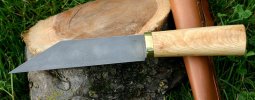I've read through this thread, and can possibly offer some insight on a few of the questions/comments.
Steven is correct that the reason many of us create damascus is because we enjoy forging and creating. Its a natural evolution. After you forge a few hundred straight steel blades, you become somewhat bored with it...or in my terms "The hammer knows what its doing." Then you dive into damascus, and the inner fire is ignited all over again. Its new, its exciting, and its fun. Next comes Mosaic...which is another evolution all its own.
Concerning the question on the micro-serration effect, that characteristic is especially noticeable when the base damascus is created from a mixture of high and low carbon steels, in a fairly high layer count, with the laminates terminating or crossing the cutting edge. That mixture will provide an end product where you will have hard and soft layers (the high carbon portion will harden, where as the low carbon will remain comparitivley soft. This means that when the blade is sharpened the end result will be the "micro-serration" that was previously mentioned. Looking at it under a microscope the view resembles tiny teeth, similar to what you would see on a hacksaw blade. This edge does not hold better than any other because of the mild steel in the mix, but it does provide an extremely aggressive cutting edge that works very well on tough or fiberous cutting chores.
Addressing what Don said about the cutting abilities of damascus....I agree. If properly produced and heat treated, it will cut no worse than a blade made from one of its components. That being said, the majority of Bladesmiths today create their damascus out of alloys that are all hardenable. The obvious example is 1080 & 15N20. The reasons that this combination is so popular with bladesmiths is that the two alloys are so compatable. They exhibt very similar expansion and contraction properties, which makes them very easy to forge weld (15N20 is basically 1075 with 1.5% nickel content, meaning that it will achieve nearly identical "as quenched" hardness as 1080), and since the two are so similar, they can be forged in ways that would tear other combinations of steels apart. The next area where this combination of steels shines is in the heat treatment. With some mixtures (different alloys combined) the expansion and contraction properties are so far apart that the steel literally tries (and often succeeds) in tearing itself apart when quenched. This is not the case with 1080 and 15N20. Again, the mix is very compatible.
Where the rubber meets the road...testing and cutting ability. Its all up to the individual Bladesmith, and what each has deemed important. I personally believe that a knife is first a tool, and no matter how great it looks, it must first cut, and cut well. All Knifemakers do not necessarily share this idea, and it is true that some have created damascus blades strictly as "eye candy". Along those lines my mind goes back to the time when "nickel damascus" was popular. It was beautiful no doubt, but because of the nickle, which is a non-hardeneing alloy, those knives did not cut well, especially in lower layer counts (which were usually the most visually striking). Another example is the "El-Cheapo" thunderfoged damascus. I have fielded more calls and emails about that stuff than I care to remember..asking me why the blades made from it would not hold up. Its all about the "overall package", from beginning to end, that makes damscus an excellent cutting material....or not. From the choice of alloys, to the proper forging, to the heat treating, to the final geometry applied to the blade.
Finally, speaking strictly for myself, I have tested many, many damascus blades over the years. Many have been my own, and many have been from other Bladesmiths. Those blades that came from established Bladesmiths, whom I know their methods and intents, performed at a level ,or in some cases better, than straight steel blades. Those blades that came from individuals with minimal experience in Damascus steel were often sub-par. Its all about the experience and knowledge of the individual creating the damascus, and the blade that follows. Can Damascus keep up with the CPM steels? I've not tested them side by side to see, but if properly produced, I believe they could/can.
Where custom damascus knives are concerned, asking for impericale evidence is pretty much a moot point. There are far too many variables within each Bladesmith's shop. From base steel choices, to forging abilities, all the way through heat treating and geometry. It all has to do with the integrity of the individual Bladesmith, their abilities, and their drive to ensure that all the necessary ingredients have been included to produce a superior cutting implement. Do all Damascus blades cut as well or better than straight steel blades? No. Can they? Yes, I believe they can. One only has to look at the tests required by the ABS to know if a Damascus blade can cut as well as a straight steel blade......
ABS Mastersmith testing requirements. If Damascus could not be made into a superior cutting tool, none of use would have ever achieved our MS rating.
Didn't mean to be so long winded, but I felt it was all necessary.


